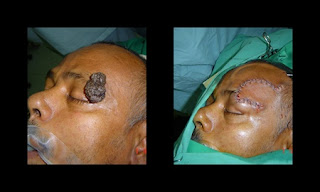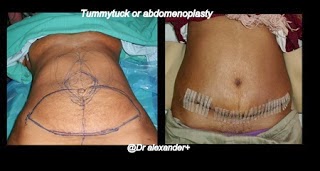picture shows an young gentleman who had a liposuction for his large
breasts or gynecomastia along with a circumferential skin
tightening around the aerola. he also had a liposuction of his tummy or abdomen
BODY
FAT: IS LIPOSUCTION THE ANSWER?
Since the origin
of mankind, human beings have relied on their body fat as an energy source.
Early man maintained a balance between body fat storage and fat utilization. As
he hunted for food, he could not afford to be obese. He had to be slim, sturdy
& strong in order to arrow a rabbit, spear a deer or run away from a wild
beast in the jungle. Our present day man lives in a concrete jungle with no
place or need to walk or run. Confined to his house or forced into a sedentary
job, he stores body fat but hardly utilizes it. Modern indoor means of
entertainment has added to his sedentary ways. Advances in science and
technology have further reduced his fat burning channels. All this means that
we cannot blame modern man for his tendency to become overweight or obese.
Is fat needed
in the body?
Besides being a
source of energy, fat in the right proportions deposited in proper anatomical
locations provides both beauty and functional advantage to the human body. The
secondary sexual characteristics that differentiate a woman from a man rely
heavily on body fat deposits. Till the 19th century voluptuous women
were considered beautiful and attractive and painters like Michelangelo
personified them in their art. The soles of our feet that carry our body weight
are supported by fat deposits and our bones, muscles and organs are protected
by fat as well. We have now come to realize that fat is more like an organ in
the body with complicated hormonal mechanisms that are still being
investigated. More recently our researchers have found that fat is a good
source for stem cells which are basic cells that can be made to differentiate
into other tissue types. These stem cells have the potential of treating many
medical diseases.
How can we lose our unwanted
fat?
Body mass index (BMI) was
developed by Belgium statistician Adolphe Quetelet
(1796-1874) and is used as a standard to
know if a person is overweight or obese.
BMI = weight (in kgs)
Height x height (in meters)

A person's weight is acceptable if the
BMI < 25. Between 25 – 30 BMI the person is considered overweight. 30-35 BMI
signifies an obese person, while
> 35 implies morbid obesity. To lose
weight simple measures like diet control and exercise regimes are advised.
Healthy eating habits with diets that are less in fat & carbohydrate along
with plenty of greens, fruits & vegetables can help an individual control
his weight. However in morbid obese patients when these measures are not
helpful bariatric surgery where surgical measures on the stomach and intestines
are used to reduce food intake or decrease absorption are used. Often in normal
persons who do diet control & exercise regimes there are areas of fat
deposits which fail to go away. Familial traits are another reason for these
fat deposits. In such patient who has troublesome & stubborn fat deposits,
Liposuction – a simple technique can be used successfully. When the tummy look
large, arms look flabby and fat, thighs cause discomfort medially
while walking, hips have fatty deposits, body
has fat that hangs around like love handles or chin appears double, then one
should consider consulting a plastic surgeon to consider if liposuction can be
of help.
What is
Liposuction & who can benefit from it?
Liposuction as
the word implies is a simple technique of sucking the body fat out through an
opening (about 1 cm). Liposuction should not be looked at as a mode of weight
reduction and is not a replacement for diet control and regular exercises.
However liposuction can effectively remove stubborn fat deposits in different
parts of the body like the ankle, calves, inner knees, inner and outer thighs,
abdomen, buttocks, hips, waist, (love handles) arms, neck, chin & cheeks.
Sometimes liposuction is done alone but one can combine it with a tummy tuck
(abdominoplasty) where the muscle tone correction and excess skin removal are
done concurrently. For male patients who have enlargement of their breast
(gynacomastia) liposuction is an effective procedure that can be done to bring
the breast back to normal size, primarily or in combination with excess skin
removal. Certain cases of fat deposits called lipomas can also be treated by
liposuction and we can avoid a large incision or scar lines. Individuals with
stubborn areas of fat that do not respond to exercises and diet control are
excellent candidates for liposuction. Fatty areas that protrude and deface the
body contours can be effectively tackled by liposuction. Many obese patients
undergo bariatric surgery to reduce their stomach size, food intake and
absorption. However following this procedure they may still have large areas of
fat deposits they fail to go away. Such patients must also consider having
liposuction.
What
precautions should be taken before undergoing Liposuction?
Before
undergoing liposuction, the surgeon should make sure that the patient is
healthy and fit to undergo the procedure. Patients who are diabetic or
hypertensive must have their blood sugars and blood pressure well under
control. Those with lung or respiratory diseases like chronic obstructive
pulmonary disease (COPD) must be examined and cleared by a physician. Similarly
those with heart diseases must be cleared by a cardiologist. Patients taking
anticoagulants (drugs that reduce blood clotting) will need to stop them prior
to surgery. Smokers should withhold smoking and alcoholics must stop drinking
prior to, during and after surgery if they wish to have good results. The
surgeon must be informed of present drug intake or allergy that the patient has
as well as any previous surgery that the patient has undergone, as this may
influence the liposuction. A few laboratory blood tests will help to make sure
that all the organs are properly functioning. The surgeon will also explain the
benefits, risk & complications after which consent form will need to be
signed.
What happens
during surgery?
The patient is
usually admitted a day prior if the surgery is under general anesthesia and the
anesthetist will review the patient's fitness for this procedure. Sometimes the
procedure is done under local anesthesia if small areas to be liposucked. Once
the patient is put to sleep (under anesthesia) the surgeon will make a small
incision(1cm) near the fat deposit. He will then introduce a canula ( metal tube)
to inject a special fluid and then apply suction to gently suck the fat out.
The amount of fat sucked out will depend on the body location. For example the
chin area may have little fat as compared to the tummy or hips. The surgeon
will also make sure that the appearance is asthetically pleasing and
symmetrical. A pressure garment is applied post operatively to support the
liposucked areas and allow the skin and tissues to evenly settle down.
What happens
after the operation?
Mild to moderate
pain can be expected post operative, which can be treated with analgesics. The
patient can be discharged the same evening or the next day once he is fully
awake and all body systems are stabilized. Some bruising, redness & edema
are expected, but they usually settle over a few weeks. The pressure garment
must be worn for 3 months or more as
decided by the physician. This will help the skin to adapt to the new contours
and the edema or swelling will reduce significantly. The operated sites should
be protected post operatively from any excess force, movement or trauma, since
these areas are still healing. Normal activities can be resumed postoperatively
depending on the surgery. For small localized deposits and fat done under local
anesthesia the patient can return to work in a day or two. For larger areas and
multiple areas like arms, chest, abdomen, thighs two or more weeks of rest may
be advised postoperatively. While diet control should be started immediately
after surgery, exercises regimes should be delayed to later than 6 weeks or
more as decided by the surgeon. Smoking should also be avoided during the
healing period as it hampers the normal healing processes.
What is the
risk of Liposuction?
As with any
surgical procedure there are also risk associated with liposuction:- Infection,
hematoma (collection of blood), Seroma (serum collection) and operated site
asymmetry, uneven contours, loose skin, scars, sensory changes, persisting pain
and swelling. Uncommonly cardiac, pulmonary complications, tissue or organ injury
and deep vein thrombosis can occur. Any
shortness of breath, chest pain or unusual heart beats post operatively must be
immediately reported to the surgeon. Fortunately, this risk is not common and
surgeon takes utmost care precautions to see that the patient has a very
satisfied experience by selecting the right candidate, doing a thorough
preoperative fitness test, meticulous surgery and sharp postoperative follow
up. The patient and the doctors must have a very candid discussion about the
entire procedure. Sometimes an additional touch up procedure maybe needed to
correct minor residual defects.
Can
Liposuction change your life?
Fat is universal
and fatty deposits in the body will continue to be a problem that most
individuals face in spite of healthy food habits and regular exercise regimes.
These fat deposits are often a source of embarrassment and there are a large
number of young women and men suffering from a poor body image due to these
fatty deposits. In your personal life or professional life liposuction can help
remove these fatty deposits on your body and enhance your body image. It can
ensure your self esteem and boost your self confidence, though it cannot change
your personality. Liposuction can help turn you into a new person and make you
stronger to face the world. Individual undergoing liposuction must take care
that they do not gain weight significantly again as this can reverse the
results of liposuction. The results of liposuction can be long-lasting &
satisfying when one maintains a healthy life style, diet control and regular
exercise regimes after a liposuction procedure. To know more about liposuction
and how you can benefit from
liposuction- schedule an appointment with Dr Alexander at KIMS Cochin.
Dr.
Alexander G
Consultant
Plastic Surgeon
KIMS
Hospital
Cochin
+
Phone: 00914843041000











































